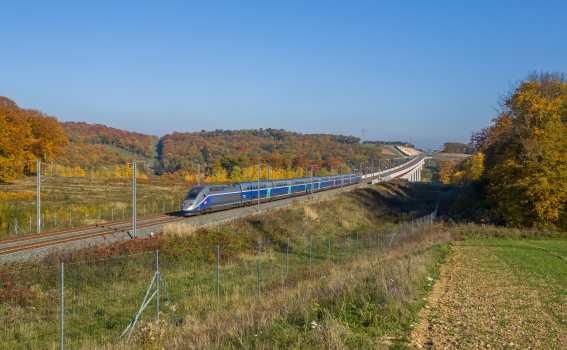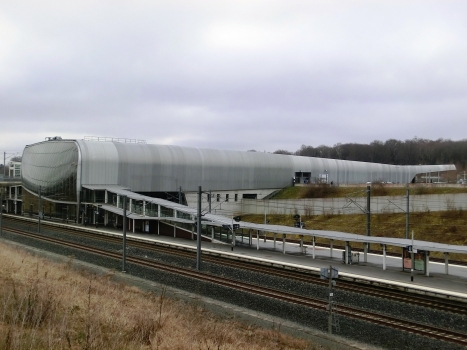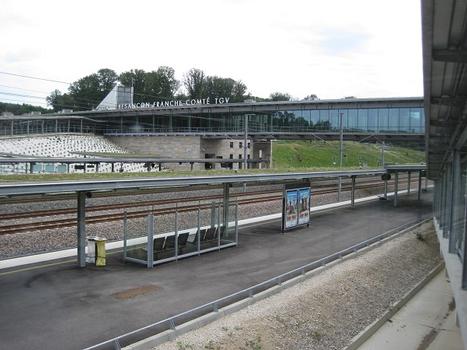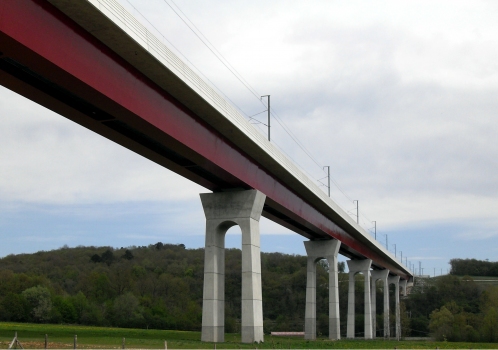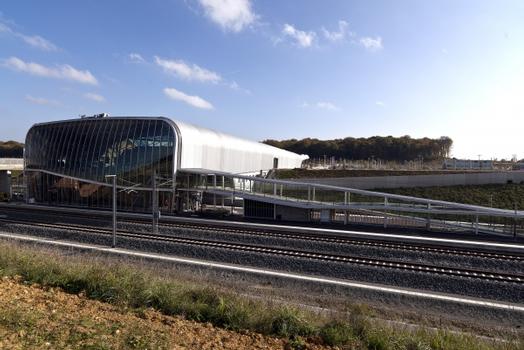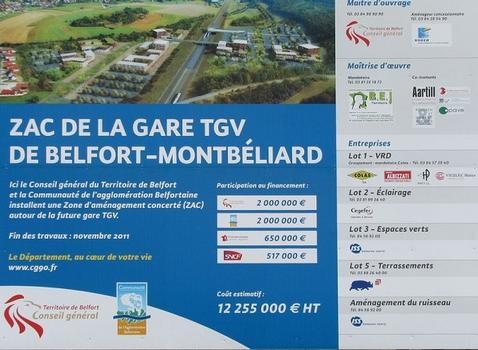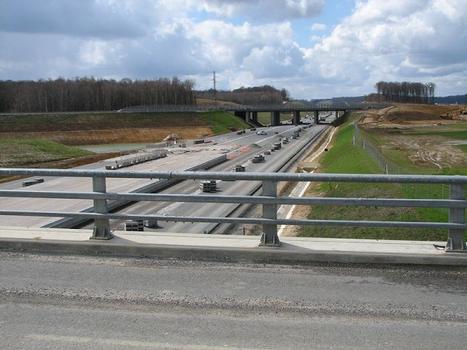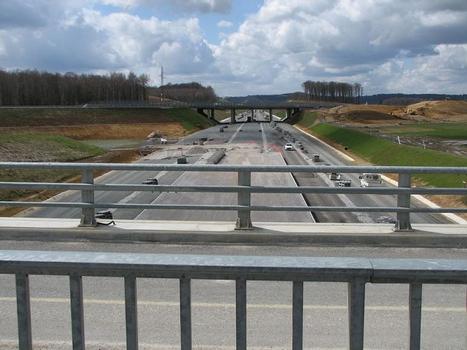General Information
| Name in local language: | LGV Rhin-Rhône |
|---|---|
| Beginning of works: | 3 July 2006 |
| Completion: | 11 December 2011 |
| Status: | in use |
Project Type
| Function / usage: |
High-speed rail line |
|---|
Location
| km | Name |
| 8.340 | |
| 51.969 | |
| 57.256 | |
| 59.917 | |
| 76.969 | |
| 77.882 | |
| 88.816 | |
| 111.925 | |
| 115.144 | |
| 117.427 | |
| 118.660 | |
| 119.020 | |
| 122.289 | |
| 124.306 | |
| 130.754 | |
| 133.858 |
Technical Information
Dimensions
| total length | 137.5 km | |
| Section A (Villers-les-Pots — Chevroz) | ||
|---|---|---|
| length | 55 km | |
| Section B (Voray-sur-Ognon — Saulnot) | ||
| length | 56 km | |
| Section C (Villers-sur-Saulnot — Petit-Croix) | ||
| length | 31 km | |
Design Loads
| design speed | 320 km/h |
Cost
| cost of construction | ca. Euro 2 312 000 000 | |
| Section A (Villers-les-Pots — Chevroz) | ||
|---|---|---|
| Lot A1 - A2 | cost of construction | Euro 58 700 000 |
| Lot A3 | cost of construction | Euro 54 100 000 |
| Lot A4 | cost of construction | Euro 114 800 000 |
| Section B (Voray-sur-Ognon — Saulnot) | ||
| Lot B1 | cost of construction | Euro 72 700 000 |
| Lot B2 - B4 | cost of construction | Euro 44 500 000 |
| Lot B3 | cost of construction | Euro 141 600 000 |
| Section C (Villers-sur-Saulnot — Petit-Croix) | ||
| Lot C1 | cost of construction | Euro 92 400 000 |
| Lot C2 | cost of construction | Euro 15 700 000 |
| Lot C3 | cost of construction | Euro 114 700 000 |
| Lot C4 | cost of construction | Euro 44 400 000 |
Excerpt from Wikipedia
The LGV Rhin-Rhône (Ligne à Grande Vitesse) is a high-speed railway line, the first in France to be presented as an inter-regional route rather than a link from the provinces to Paris, though it actually is used by some trains to/from Paris. The first phase of the eastern branch opened on 11 December 2011. Construction of ist second phase was expected to start in 2014 but has unclear funding at this stage.
If completed, LGV Rhin-Rhône would have three branches:
- The Eastern branch, 190 km (120 mi) from Genlis, near Dijon to Lutterbach, near Mulhouse, of which 140 km (87 mi) have been built
- The Western branch, crossing Dijon, joining the LGV Sud-Est near Montbard and making the line a connection between Dijon and Paris
- The Southern branch, from Dijon to Lyon
The construction of the latter two branches and of the second phase of the Eastern branch is currently unfunded.
Running north-south, the Southern branch line would help connect Germany, the north of Switzerland, and eastern France on the one hand with the valleys of the Saône, Rhône, the Mediterranean arc and finally Catalonia on the other. The east-west Eastern and Western branches lines would help connect on the one hand London, Brussels, Lille and Île-de-France (i.e., Paris and surroundings) with Burgundy, Franche-Comté, south Alsace, southern Baden, and Switzerland on the other.
A connection will be built at Perrigny, south of Dijon, to serve TGV and freight trains. Auxon station will be connected to Besançon-Viotte station by a railway line which could be also used for commuter trains.
It is projected that 12 million passengers per year will use the LGV Rhine-Rhône service.
Eastern branch
The first phase of the eastern branch runs 140 km (87 mi) of the 190 km planned length, connecting Villers-les-Pots (east of Dijon) to Petit-Croix (southeast of Belfort), was officially opened by President Nicolas Sarkozy on 8 September 2011, with passenger services starting on 11 December 2011.
The eastern branch is used by TGV trains operated by SNCF, the French national railway company. It will become a key link in both the North-South and East-West transport corridors. The line carries regional, national, and intra-European traffic. Mulhouse provides connection to Basel, Switzerland, and then to southwestern Germany and northwestern Switzerland.
Finance
The financing agreement for the first phase of the eastern branch was signed on 28 February 2006. The estimated cost of the first section of the eastern branch is 2.312 billion euros, shared between many organisations.
The largest contributors of funds are the Government of France (€751 million), the maintainer of the French rail network RFF (€642 million) and the European Union (€200 million). Significant funding also came from the three regions of France that the line travels through: Franche-Comté (€316 million), Alsace (€206 million), and Burgundy (€131 million). A further €66 million was funded by the Government of Switzerland.
Construction
Preparatory works began in 2005, and construction officially started on 3 July 2006 with a ceremony in Les Magny, Haute-Saône. Actual construction of the first section started north of Besançon on 7 August 2006.
Réseau Ferré de France appointed French engineering and consulting companies Setec and Egis to build the line. The construction of the Eastern branch was divided into two sections :
- The first section is 140 km (87 mi) long, running from Villers-les-Pots, Côte-d'Or (east of Dijon) to Petit-Croix, Territoire de Belfort (east of Belfort). This section opened for service on 11 December 2011.
- The second section, for which construction was initially planned to begin in 2014 but is not funded yet, would add 50 km (31 mi) length to the line. This section would complete the eastern branch from Villers-les-Pots to Dijon, Côte-d'Or, with 15 km (9.3 mi) in the west, and from Petit-Croix to Mulhouse, Haut-Rhin, with 35 km (22 mi) in the east.
Text imported from Wikipedia article "LGV Rhin-Rhône" and modified on July 22, 2019 according to the CC-BY-SA 4.0 International license.
Participants
Relevant Web Sites
Relevant Publications
- (2006): Démarrage du chantier de la LGV Rhin-Rhône. In: Le Moniteur des Travaux Publics et du Bâtiment, n. 5353 (30 June 2006), pp. 16-17.
- (2008): La grande vitesse au coeur des régions. In: Construction moderne ( 2008), pp. 23-26.
- La LGV Rhin-Rhône sur les rails. In: Le Moniteur des Travaux Publics et du Bâtiment, n. 5421 (19 October 2007), pp. 9.
- (2010): LGV Rhin-Rhône, Branche Est - Les études du viaduc de la Savoureuse. In: Travaux, n. 870 (March 2010).
- (2006): LGV Rhin-Rhône. Roger Martin ouvre la voie. In: Chantiers de France, n. 393 (September 2006), pp. 34-36.
- About this
data sheet - Structure-ID
10000645 - Published on:
28/03/2005 - Last updated on:
28/05/2021

